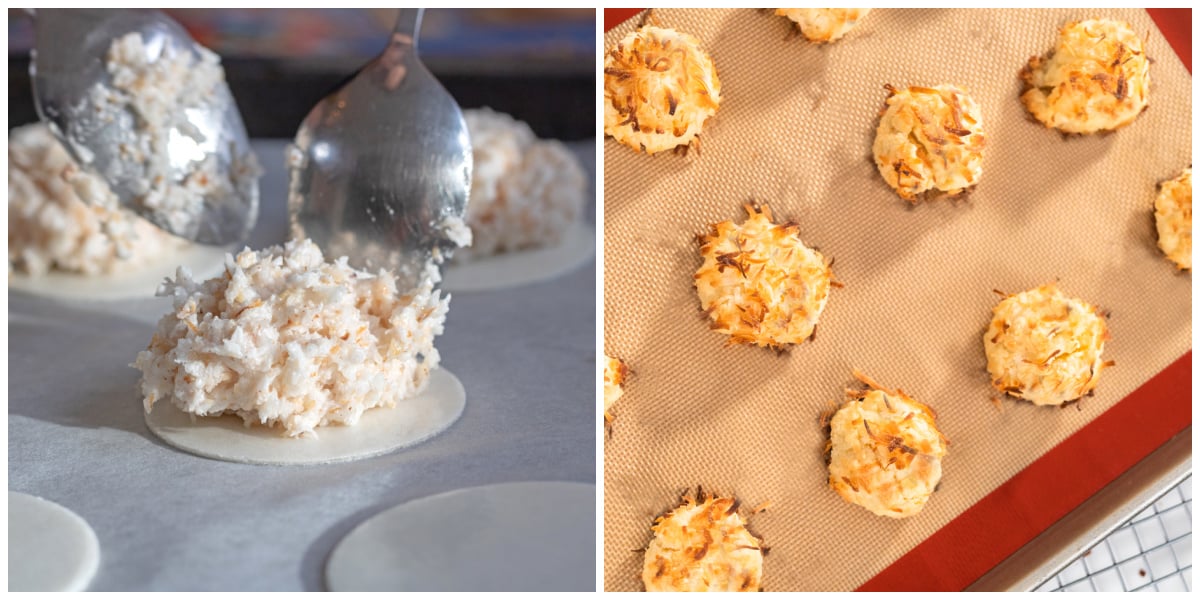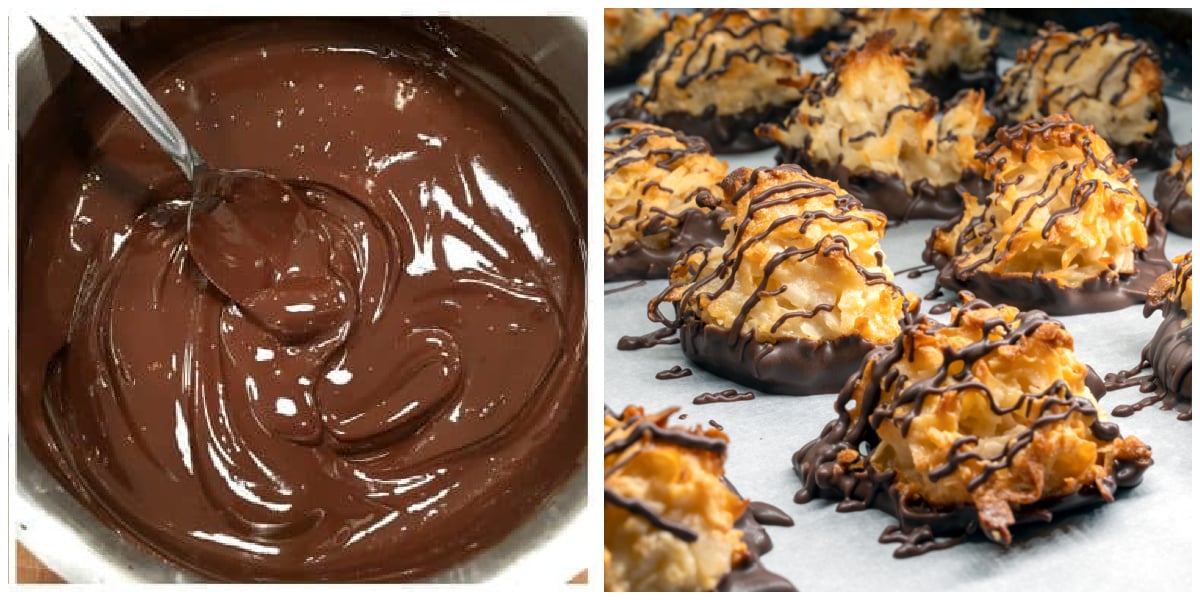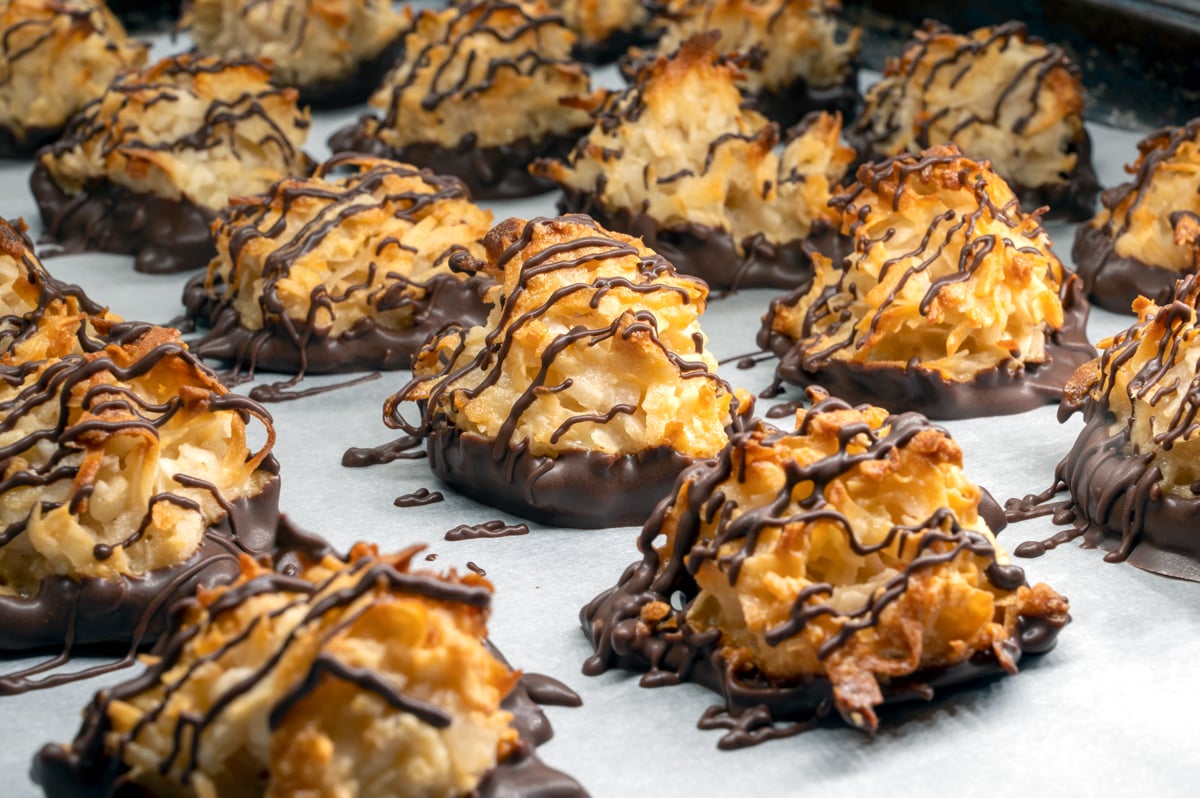Kokosmakronen (German Coconut Macaroons)
This post may contain affiliate links. See my disclosure policy.
A traditional Kokosmakronen recipe, the beloved coconut cookies enjoyed all year round but especially at Christmas time. These German coconut macaroons are delightfully chewy on the inside, slightly crispy and golden on the outside, and bursting with the delicious flavor of toasted coconut!

What are Kokosmakronen?
Kokosmakronen are German coconut macaroons, a type of cookie that is particularly popular during the Christmas season in Germany. They are made with just a few ingredients, primarily dried shredded coconut, egg whites, and sugar. The egg whites are beaten with the sugar until they’re stiff, the shredded coconut is folded into the egg whites, the mixture is scooped into mounds on a baking sheet, and they are baked until golden brown.
Kokosmakronen are known for their chewy and moist texture and their toasted coconut flavor. As an option the macaroons can be dipped in chocolate on the bottom and/or drizzled with chocolate over the top. They are enjoyed all year round but are a favorite during the holidays.
German Kokosmakronen vs. American Coconut Macaroons
There are a few things that differentiate German Kokosmakronen from American coconut macaroons. First of all, German Kokosmakronen use unsweetened shredded coconut (it’s difficult to even find sweetened coconut in Germany). This creates a little different texture, allowing the coconut to toast up a more crispily. Also, unlike American coconut macaroons, German Kokosmakronen do not use sweetened condensed milk (it’s not a widely used product in Germany). So between using unsweetened coconut and no sweetened condensed milk, German Kokosmakronen are not as cloyingly sweet as their American cousin. If you do use sweetened coconut, cut down a little on the granulated sugar. Finally, Germans commonly use Back Oblaten, super thin wafers, as a base for the macaroons. Let’s take a look at those in more detail below.

What are Oblaten?
Back Oblaten, also known simply as oblaten, are very thin, round wheat wafers. They’re very similar to communion wafers, only larger in diameter (and of course used for very different purposes :) They’re used in German baking, most notably for things like Lebkuchen, Haselnussmakronen and these coconut macaroons. Oblaten come in a variety of sizes depending on what you’re using them for. Oblaten serve several purposes:
- Prevent Sticking: Back oblaten serve as a non-stick layer between the dough and the baking surface, preventing it from sticking to the parchment paper or baking mat. They’re particularly useful for very sticky pastry/cookie doughs. The Oblaten also help to hold the sticky doughs together.
- Uniform Baking: The Oblaten wafers provide a consistent base that increases even heat distribution during the baking process.
- Texture and Appearance: The addition of Oblaten on the bottom of the baked goods contributes a nice crispy-chewy texture, enhancing the overall mouthfeel.
Back Oblaten can be purchased online. For these Kokosmakronen you typically use size 40mm Oblaten. If you prefer them a little bigger you can use size 50mm Oblaten. If you need gluten free coconut macaroons you can omit the Oblaten. Take precaution to prevent sticking by giving your parchment paper a light spray of oil.
With or Without Chocolate?
Traditionally most Germans made their Kokosmakronen without chocolate but today you’ll also find them drizzled and/or dipped in dark chocolate, milk chocolate, or white chocolate. I grew up in Germany eating them both with and without chocolate and they’re delicious both ways. During the Christmas holidays I like to make a combination of plain Kokosmakronen along with milk, dark, and white chocolate dipped ones for variety to include on my German Christmas cookie plates that I give to friends and loved ones.

Kokosmakronen Recipe
Let’s get started!
Preheat the oven to 325 F and line two baking sheet with either parchment paper or a silicone mat. Distribute 40 Back Oblaten on the baking sheets.
In a dry skillet, toast the coconut over medium heat for a few minutes until roughly half of it turns golden. This step is optional but it brings out more of the coconut flavor which I like. Transfer the coconut to a plate to cool.
In a mixing bowl beat the egg whites until they’re foamy then add the salt and vanilla sugar. Gradually add the granulated sugar as you continue to beat the egg whites. Beat until stiff peaks form. Gently fold in the coconut.

Use two spoons or a medium cookie scoop to evenly distribute the mixture onto the Oblaten.
Bake the coconut macaroons on the middle shelf of the oven for 25-30 minutes or until the tops begin to brown. How brown you let your macaroons get is up to you. Some prefer them paler, some browner. I like them a deep golden because that extra toasting further brings out the flavor of the coconut.

Transfer the coconut macaroons to a wire rack to cool completely.
If dipping them in chocolate, gently melt the chocolate in the microwave, stirring every 20 seconds, or over a double boiler until smooth. Dip and/or drizzle each macaroon and set them on parchment paper to fully set. Once set, transfer them to an airtight container. They will keep for up to a week.

Can You Freeze Coconut Macaroons?
Yes! Layer them between parchment paper to avoid sticking and freeze for up to 3 months. To defrost them remove them from the freezer and let them sit at room temperature until thawed.
Enjoy!

For more delicious German Christmas goodies be sure to try my:
- Zimtsterne (German Cinnamon Stars)
- Vanillekipferl (Vanilla Crescent Cookies)
- Pfeffernüsse (German Iced Spiced Cookies)
- Lebkuchen (Nürnberger Elisenlebkuchen)
- Stollen (German Christmas Bread)
- Springerle (German Embossed Cookies)
- Printen (Aachener Gingerbread)
- Speculoos (Gingerbread Shortcrust Cookies)
- Bethmännchen (Marzipan Cookies)
- Heidesand (Browned Butter Shortbread Cookies)
- Marzipan (or Almond Paste)
Save This Recipe

Kokosmakronen (German Coconut Macaroons)
Ingredients
- 4 egg whites
- 3/4 cup granulated sugar
- 1 packet vanillezucker (vanilla sugar) , can substitute 3/4 teaspoon vanilla extract
- 1/8 teaspoon salt
- 3 1/2 cups unsweetened shredded coconut
- 8 ounces dark, milk, or white chocolate for dipping or drizzling (optional), chopped (or about 1 1/3 cup chocolate chips)
- 40 size 40mm Back Oblaten (see blog post for reasons these are used), for GF omit the Oblaten
Instructions
- Preheat the oven to 325 F and line two baking sheet with either parchment paper or a silicone mat. Distribute 40 Back Oblaten on the baking sheets.
- In a dry skillet, toast the coconut over medium heat for a few minutes until roughly half of the coconut turns golden. This step is optional but it brings out more of the coconut flavor. Transfer the coconut to a plate to cool.
- In a mixing bowl beat the egg whites until they're foamy then add the salt and vanilla sugar. Gradually add the granulated sugar as you continue to beat the egg whites. Beat until stiff peaks form. Gently fold in the coconut.Use two spoons or a medium cookie scoop to evenly distribute the mixture onto the Oblaten.Bake the coconut macaroons on the middle shelf of the oven for 25-30 minutes until they're golden brown. How brown you let your macaroons get is up to you. Some prefer them paler, some browner to bring out more coconut flavor. Transfer the coconut macaroons to a wire rack to cool completely.
- If dipping the macaroons in chocolate, gently melt the chocolate in the microwave, stirring every 20 seconds, or over a double boiler until smooth. Dip and/or drizzle each macaroon and set them on parchment paper to fully set. Once set, transfer them to an airtight container. The Kokosmakronen will keep for up to a week. You can also freeze them for up to 3 months (layer them between parchment paper to avoid sticking) and let them thaw at room temperature.
Nutrition



















Thanks for yet another wonderful recipe Kimberley.
I am so pleased to find your recipe calls for unsweetened shredded coconut because it does not exist in New Zealand either.
I also make your candied peel every year, it is just delicious, so different from the bought product, goodness knows what is in that to make the taste so weird!
Then I use it in your Stollen recipe. Such tasty treats even though it is summer time here!
Thank you so much, Carol, I’m thrilled that the candied peel and Stollen have become traditions in your home! <3 And I'm happy you also enjoyed these Kokosmakronen, thank you! :)
These were so scrumptious! My German neighbor used to make me Kokosmakronen every year and I never thought to ask her for the recipe. These are just like I remember them and I am so happy to be able to make them now. I shared some with the my colleagues at work and they’re already requesting more :)
Thank you so much, Helena, I’m thrilled that you enjoyed them and appreciate the feedback!
Hello there, This recipe looks so delicious, I was wondering if I used Nut thins in place of the Oblaten. That would make them gluten free. I have never heard of oblaten before now. Nut thins are just thin nut crackers usually made out of almonds, Thanks so much for your recipes, they all look so delicious
Hi Linda, that’s definitely the first time I’ve heard that one! :) They’ll work from a structural standpoint, providing a foundation on which to place the batter. And from a flavor standpoint, I haven’t had nut thins but it doesn’t sound like it would be terrible. I would imagine they’re probably a little salty – who know, you may end up inventing something akin to caramel covered pretzels only instead it’s coconut macaroon nut thins! :) If you give it a try let us know how it goes!
Oh my goodness!! These are heavenly and so very easy to make. Thank you so much for transporting me back to my childhood in Germany!
Thank you, Sabine, I’m so glad you enjoyed them! :)